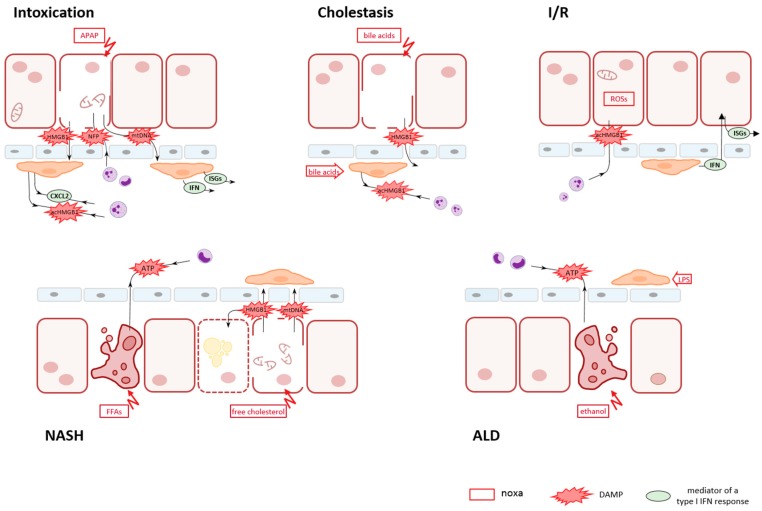Figure 1.
Schematic outline on key events in sterile liver disease conditions. Cell injury of hepatic parenchyma can be provoked by many different noxae such as xenobiotics in intoxication conditions (e.g., APAP), endogenous compounds in cholestatic obstruction (e.g., bile acids) or NASH (e.g., free fatty acids (FFAs), the generation of reactive oxygen species (ROSs) in I/R conditions, or by ethanol in ALD. The release of DAMPs in a first line is common to all conditions. It might be accomplished either actively via secretion from viable or from dying, apoptotic cells or passively via leaking out from necrotic cells. In APAP intoxication, necrotic cell death predominates with the release of HMGB1, mtDNA, and N-formyl peptides (NFP). In cholestasis, bile acids cause a disintegration of hepatocytes, thereby generating a shunt and allowing bile constituents to reach the blood stream and to act also on KCs. In experimental I/R injury, the first insult was demonstrated to be an active secretion of acHMGB1 from intact hepatocytes, while in later stages IFNs become involved in. In the pathogenesis of NASH, concomitant apoptotic and necrotic death of hepatocytes caused by different lipid entities is indicated with the regulated, active release of ATP by apoptotic cells and the passive release of HBMG1 and mtDNA by necrotic cells. In ALD, ethanol-driven apoptosis of parenchymal cells is superposed by microbial products, e.g., LPS, as a result of an impairment of the intestinal mucosa and an increased gut permeability. The first line of DAMPs released by hepatocytes provokes release of a second line of DAMPs and mediators by resident KCs and granulocytes. The composition of second-line DAMPs and mediators governs a secondary innate immune response. This secondary response might comprise cell death of different mode than the initial one, further attraction of neutrophils and monocytes from the circulation, and the induction of an IFN response, thus boosting sterile hepatic inflammation.

